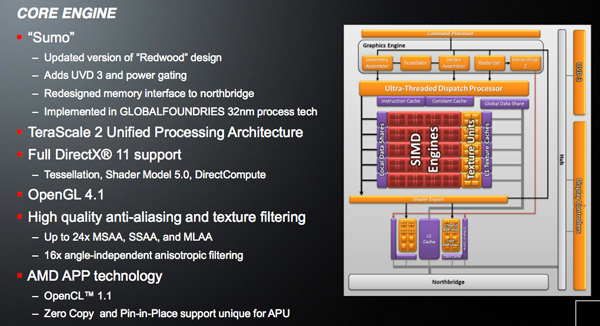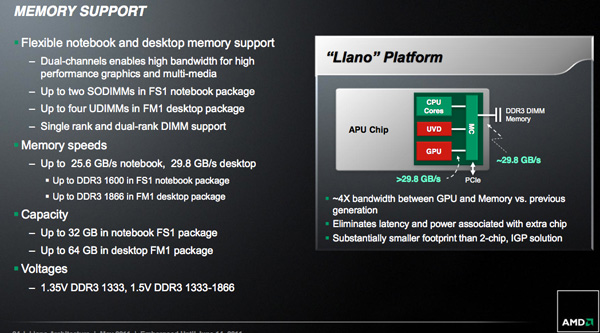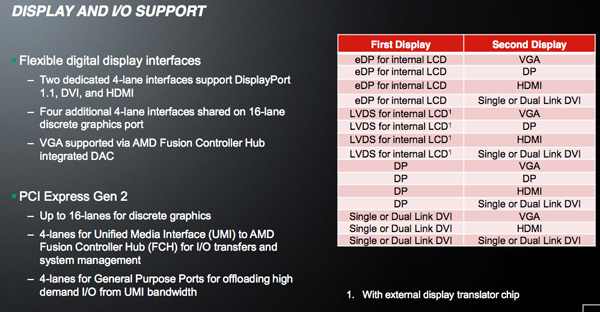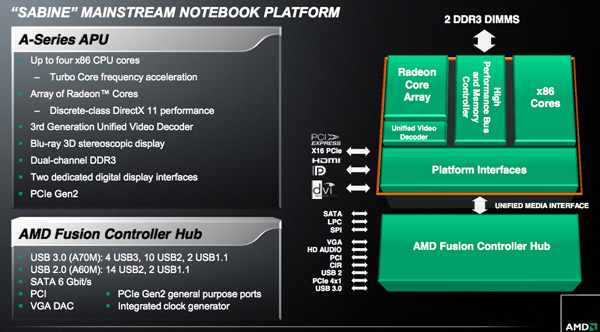The AMD Llano Notebook Review: Competing in the Mobile Market
by Jarred Walton & Anand Lal Shimpi on June 14, 2011 12:01 AM ESTThe GPU
While the Llano CPU cores may be in need of a major overhaul, Llano's GPU is as new as it gets. Technically based off of AMD's Redwood core (Radeon HD 5570) with some enhancements, Llano's GPU is codenamed Sumo.
The DX11 GPU features five SIMD arrays, each with 80 cores for a total of 400 shader processors. Similar to the updates we saw with this year's Northern Islands GPUs, Sumo does add UVD3 support to the Redwood architecture. Of course since Sumo shares the same die as the Llano CPU cores it is built on GlobalFoundries' 32nm process, making this the first AMD GPU fabbed at GlobalFoundries and not TSMC.
For everything behind the memory controller Sumo is virtually identical to Redwood. Where Sumo differs is in its memory interface. Although Llano is AMD's first performance oriented APU, it's still constrained by a 128-bit wide DDR3 memory interface. That dual-channel memory interface has to be shared by all four Llano cores as well as the Sumo GPU and as a result, arbitration is very important.
AMD shared a few choice details about the Llano memory controller architecture. To begin, AMD guarantees more than 30GB/s of bandwidth is available between the GPU and the memory controller—in other words, the path from GPU to the memory controller won't become a bottleneck. The GPU/memory controller link (i.e. within the APU die) can apparently scale up to as much as 50GB/s to support future APUs with even faster memory interfaces. Note that unlike previous integrated graphics solutions, there is no support for dedicated external memory—this is a pure shared memory architecture.
Second, and most importantly, AMD can dynamically prioritize memory bandwidth between the CPU and GPU. In most cases, when both processors are heavily consuming data, the GPU is given priority over the CPU. Given today's workloads, prioritizing the GPU for memory accesses makes sense when it's running full tilt. The chances of you stressing all four CPU cores and running at full GPU memory bandwidth requirements are pretty slim today.
With 400 shader processors behind a shared 128-bit DDR3 memory interface, the upper bound for Sumo performance is the Radeon HD 5570. In practice, you should expect performance to be noticeably lower since the GPU does have to share its precious memory bandwidth with up to four x86 CPU cores.
The mobile version of Llano supports up to DDR3-1600 while the desktop parts can run at up to DDR3-1866. Maximum memory capacities are 32GB and 64GB for notebooks and desktops, respectively.
Llano has a total of 24 PCIe Gen 2 lanes at its disposal. Sixteen of those lanes can be used for external graphics. Four of the lanes can be used for devices that need low latency/high bandwidth access to the APU itself (e.g. Gigabit ethernet). The remaining four lanes are used to connect the APU to its sole partner in crime: the Fusion Controller Hub.
AMD is particularly proud of the display output configurations supported by Llano. The possible combinations are listed below:
Chipsets
AMD will offer two Fusion Controller Hubs (FCHs) as options for Llano: A70M and A60M. The only difference between the two is in their support for USB 3.0; the A70M has four USB 3.0 ports while the A60M has none.
Both FCHs support 6Gbps SATA and perform just as well as AMD's 8-series chipset (or Intel's Z68) with a high performance SSD. USB 3.0 performance is also comparable to 3rd party solutions we've seen deployed on motherboards already.















177 Comments
View All Comments
ET - Tuesday, June 14, 2011 - link
Legit Reviews found a big difference in game performance between AC and battery (see here: http://www.legitreviews.com/article/1636/5/). This made Llano and the i5 perform about the same on battery in Resident Evil 5. I assume that benchmarks here are on AC, so it would be interesting to test on battery.DXM1 - Tuesday, June 14, 2011 - link
Great Review Anand! Once again we know intel is the best at all things computing. I liked how you included the i7 with 460m up to THREE times in some benchmarks. It was like you kept reminding us and casual consumers that massively more expensive parts perform better... Even if you test the same set-up 3 times in a row!I have to tell you that seeing the 3 intel blue bars on the top made me sigh with relief, I was worried that you may actually compare llano to the parts like i3 and i5 where it is actually meant to compete (like some other silly reviewers). My only gripe is you didnt add i7-2600kand gtx 580 OC'ed as those would have made the gap even wider from the AMD system.
One question I did have for you is, how much does Intel pay nowadays for dishonest reviewing practices? Im short on cash because my job doesnt pay well and I was hoping to open up a website and promote intel just like you. Maybe we could even become partners and link to each other websites I think that would be cool.
PS, could you post how much your integrity was worth before you auctioned it off to Intel? Im sure some of your fans would be eager to know.
Your ex Reader, DXM1
Sharken03 - Tuesday, June 14, 2011 - link
Dont feed this troll, Anandtech is a great hardware site.Jamahl - Tuesday, June 14, 2011 - link
Troll? it's the truth. What was the fucking point in showing 3x identical intel systems except to put 3x intel systems at the top of most benchmarks? It's goddam pathetic.JarredWalton - Tuesday, June 14, 2011 - link
Or, I included these laptops because they're the only ones I still had where I could rerun all the benchmarks (specifically, PCMark 7 and 3DMark 11). Oh, snap! Heaven forbid we think about that. And if you read the 8000+ words of commentary, you'll notice how often we praise Intel's placement at the top of the charts -- and of course we completely ignore when they fall to the bottom of the battery life charts.I wish I had a secret stash of all the laptops I've tested in the last six months, because then I wouldn't have even bothered with including more than one GTX 460M + SNB. But your suggestion that we *not* include laptops because it pushes Llano down is even worse than what we've done. Should we only show laptops where AMD is better? Or maybe just laptops that cost under $700? Maybe we need to dig out an old CULV setup and then benchmark GMA 4500MHD again so we can laugh at Intel's IGP from two years ago?
If you want a look at every laptop we've tested and where Llano falls in the grand scheme of things, I suggest checking into our Mobile Bench results. Hint: it's in the upper part of battery life, and in the middle to lower part of CPU and GPU tests; if you only look at IGPs, though, it's the fastest IGP. Hmm... that sounds a lot like what we said in our conclusion.
pfastovsky - Tuesday, June 14, 2011 - link
JarredI think its a fair comment that asks Anandtech to keep their graphs in an article consistent with the same laptop set across a testing segment. As you said, you had to rerun all the benchmarks so why are the Civ laptops listed so different from Mass Effect, Starcraft etc?
Thanks
ET - Tuesday, June 14, 2011 - link
The comment may be fair, and it's been mentioned before, but accusing Anandtech of being paid by Intel isn't.krumme - Tuesday, June 14, 2011 - link
None of this explains the 3 identical setup.How on earth to you think it looks like?
Its simply utterly pathetic, and an insult at our IQ
I am no fan at this Llano apu, and from the start. think AMD should just have posponed it, and used the capacity for BD and serverspace, but this review is just far out.
The important issue about llano have always been the power profile, and AMD just deliver in spades here. Far beyound expectations. The OEM will sell this like zakate, and the new trinity will not make it significantly better on the market than this with upgraded star cores.
JarredWalton - Tuesday, June 14, 2011 - link
You know what's utterly pathetic and an insult to people's IQ? The suggestion that they can't actually comprehend the graphs. But just to show you that I have no "agenda" and I'm not trying to make AMD's Llano look worse than it is, I have taken a couple hours to go through, remove all the extra data, and regenerate all the graphs. (Yes, folks, creating all of these things does take time and our UI for doing this is not as easy as you might expect.) Of course, not all of the i7-2630QM + GTX 460M notebooks performed equally, so now I've "punished" Intel by showing worse results in some tests. Oh noes!Anyway, thanks for the input and sorry if the inclusion of more laptops was deemed offensive by some. They're just charts, people, and I even colored the "high-end" laptops bright blue so that you could easily filter them out in your mind. You know, something like: "Oh, those lines at the top are bright blue, so they're for quad-core Sandy Bridge laptops that cost about twice what the Llano laptop is expected to cost."
AnandThenMan - Tuesday, June 14, 2011 - link
Although I don't like the approach of the poster taking issue with the graphs, I completely agree on principle. This site has shown a clear pattern of making sure certain hardware always occupies the top of the graphs. Always. And don't insult our intelligence and pretend otherwise, please.Need I also remind people that this site included hand picked, overclocked Nvidia supplied cards (to the insistence of Nvidia) despite a policy that forbids this. I would caution people to take all results on this site with a grain of salt.